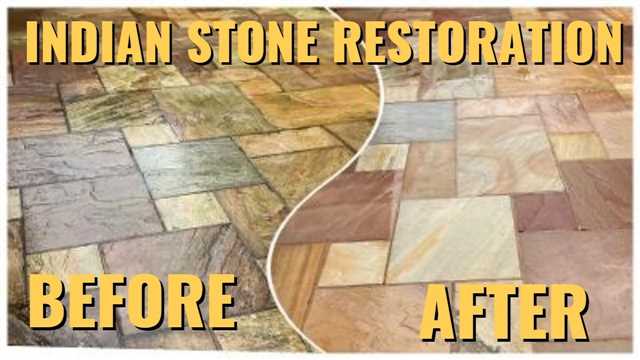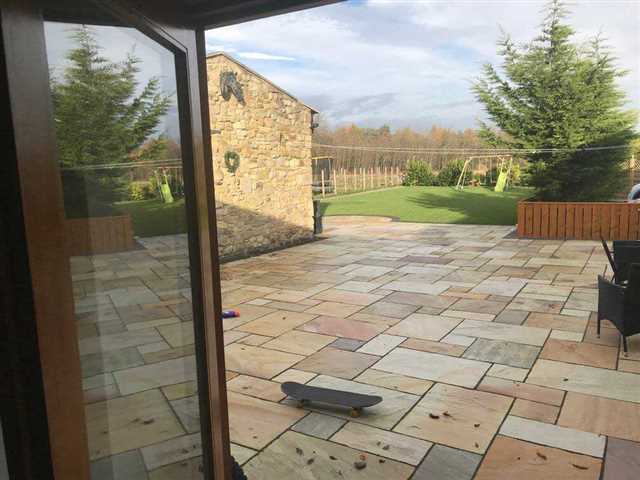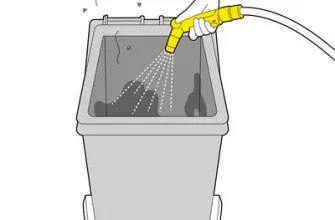
Cleaning Indian Sandstone can be a challenging task, especially if you’re not sure where to start. With so many options and considerations, choosing the right cleaning method can seem overwhelming. But don’t worry, we’re here to help!
In this helpful guide, we’ll discuss 8 easy steps to clean your dirty Indian Sandstone and bring back its natural beauty. No matter the severity of the dirt and blemishes, you’ll find the process straightforward and the results satisfying.
The versatility of Indian Sandstone in gardens and outdoor spaces means it often becomes a colony for weeds and microorganisms. If you’ve noticed weeds growing between the paving, or your sandstone is looking dirty and worn, it’s time to take action.
First off, you’ll need to gather the necessary tools and solutions. Grab a pressure washer with an adjustable nozzle, a scrubbing brush, and a mild soap or special sandstone cleaning solution. These items will help you along the way in your cleaning journey.
Before starting the cleaning process, be sure to remove any furniture or objects on the sandstone. This will ensure a thorough cleaning and prevent any damage to your belongings. Pay special attention to any blemishes or stains that may require additional care.
Now that you’re ready to begin, start by using a pressure washer to loosen any dirt or debris on the surface. Adjust the nozzle to a low setting to avoid causing any damage to the sandstone. Be careful not to spend too much time in one area, as this can lead to uneven cleaning or erosion of the stone.
Next, mix a mild soap or sandstone cleaning solution with water. Using a scrubbing brush, work the soapy solution into the sandstone, paying close attention to any particularly dirty or stained areas. Scrub in a circular motion to ensure equal coverage.
After scrubbing, rinse the sandstone thoroughly with clean water. Make sure to remove all soapy residue and dirt from the surface. This step is crucial to prevent any post-cleaning heartache and to keep your sandstone looking its best.
If you notice any lingering stains or stubborn dirt, you may need to apply a stronger cleaning solution or use a more vigorous scrubbing technique. But be careful not to use acid-based solutions, as these can cause further damage to the sandstone.
Once you’re satisfied with the cleanliness of your sandstone, give it a final rinse with clean water. Pay extra attention to any crevices or gaps between the paving to ensure a thorough cleaning.
With these 8 easy steps, you’ll be able to clean your Indian Sandstone without much hassle. Remember to take your time, give attention to detail, and choose the right solutions for your specific issue. By following this guide, you’ll be able to enjoy a clean and beautiful Indian Sandstone patio or walkway, free from dirt, weeds, and other unsightly blemishes.
Can You Use a Power Washer on Indian Sandstone Paving
Power washers are a popular choice when it comes to cleaning outdoor surfaces, but can they be used on Indian Sandstone paving? The answer is usually yes, but with some precautions and adjustments.
First, you need to identify the type of sandstone you have. Some sandstones are softer and more prone to damage, while others are harder and can handle higher pressure. Adjust the power washer accordingly to avoid any issues.
Using a power washer on Indian Sandstone paving can be effective in removing dirt, stains, and algae. However, overzealous power washing can damage the sandstone, creating cracks and wearing away the surface. Browse through the different nozzle options and choose a wider angle for a gentler cleaning process.
Before using the power washer, you may need to remove any weeds or moss from between the stones. Hand brushing or using a weed killer can help with this process. Additionally, consider using a treatment to prevent future algae or moss growth.
What’s most important is to ensure that you’ve prepped your sandstone properly before power washing. Remove any loose dirt or debris and wet the surface thoroughly. This will prevent any sand or dirt from washing away during the cleaning process.
When using the power washer, keep the nozzle at a safe distance from the sandstone. Start from a low pressure setting and gradually increase if needed. Make sure to keep the nozzle moving constantly to prevent any damage to the stone.
After power washing, it’s always a good idea to give your Indian Sandstone paving a thorough rinse with fresh water, washing away any remaining dirt or detergent residue. Additionally, if there are any noticeable stains or marks, you may need to do some additional hand scrubbing or use a specific cleaning agent.
In conclusion, power washing can be a helpful tool in cleaning Indian Sandstone paving, but you must take precautions and adjust accordingly. By following these steps, you can ensure that your sandstone stays clean and free from any damage caused by power washing.
Use a Cleaning Solution if Needed
While a thorough wash-down with just water may be sufficient to remove surface dirt, algae, and moss from your Indian sandstone paving, there may be instances when you need a cleaning solution to tackle tougher stains or build-ups.
If you notice stubborn grime, blemishes, or discoloration on your paving, using a cleaning solution can be very helpful. This can be a mixture of water and a mild detergent, or you can choose from a range of specialized stone cleaning products available in the market.
When using a cleaning solution, it’s important to follow the instructions provided by the manufacturer. Make sure to dilute the solution as directed and test it on a small, inconspicuous area of your paving before applying it to the entire surface.
Using a stiff brush or a pressure washer nozzle with an adjustable spray pattern can help to apply the cleaning solution evenly over the paving. Be careful not to use excessive pressure, as this can damage the sandstone material.
After applying the cleaning solution, let it sit for a few minutes to loosen any tough stains or build-ups. Then, use a brush or pressure washer to scrub or rinse away the dirt and grime.
If there are any remaining stains or marks, you may need to repeat the cleaning process or try a different cleaning solution. Remember to always rinse the paving thoroughly after cleaning to remove any residue.
Using a cleaning solution can be especially beneficial for removing moss and algae, which can be challenging to eliminate with water alone. These organisms can cause slippery surfaces and create an unsafe environment. Moreover, moss and algae can lead to moisture build-ups, which can damage the sandstone paving over time.
By identifying the cause of these organic infections and using the proper cleaning solution, you can effectively eliminate moss and algae from your Indian sandstone paving.
One of the simplest mixtures you can create for this purpose is equal parts water and vinegar. This natural solution can help to kill the moss and algae, while also preventing future growth.
In addition to moss and algae, there may also be other organic materials like weeds and lichens on your paving. Washing them away with a cleaning solution will help to keep your Indian sandstone paving clean and free from these unwanted additions.
It’s worth noting that while cleaning solutions can be effective in removing stains and blemishes, they should be used sparingly and as a last resort. Regular maintenance and preventive care can help to minimize the need for these cleaning solutions in the long run.
Choose the Right Nozzle for the Job

When it comes to cleaning your Indian sandstone, one of the most essential steps is choosing the right nozzle for the wash-down. With modern pressure washers offering a wide range of nozzle options, it’s important to understand which one is best suited for the task at hand.
Indian sandstone can develop various build-ups over time, including dirt, grime, algae, moss, and even stubborn stains. Depending on what needs to be removed, different nozzle types can provide better results.
For general cleaning and removing loose dirt and debris, a wide-angle nozzle is usually sufficient. This type of nozzle creates a broad spray pattern, covering a larger area and making the cleaning process faster and more efficient.
If you’re dealing with tougher stains or moss, a rotary nozzle can be a great tool. This nozzle spins the water rapidly, providing additional pressure to break apart build-ups and clean deeply embedded dirt. However, it’s essential to be careful when using a rotary nozzle to avoid damaging the sandstone surface.
In some cases, a narrow-angle or pinpoint nozzle might be necessary to target specific areas or remove stubborn build-ups. These nozzles provide a concentrated and powerful stream of water, giving you precise control over the cleaning process.
When using a pressure washer, it’s crucial to start with a low-pressure setting and test it on a small, inconspicuous area of the sandstone. This ensures that you won’t damage the stone and helps you determine the appropriate nozzle and pressure for the job.
Additionally, before you begin washing the sandstone, it’s a good idea to give it a gentle scrub using a soft brush or broom. This helps remove loose dirt and debris and ensures a more effective cleaning process.
Remember, different sandstones may have specific care requirements, so it’s always a good idea to consult the manufacturer’s guidelines or seek professional advice. Taking proper care of your sandstone paving will not only improve its appearance, but it can also prolong its lifespan and prevent future issues.
So, the next time you’re cleaning your Indian sandstone, choose the right nozzle for the job, and you’ll be amazed at the sublime results you can achieve.
What You’ll Need
Before you begin cleaning your Indian Sandstone, make sure you have the following items handy:
- Algae and weed killer: The best solution for removing algae and weeds from your sandstone.
- Soapy water: A mixture of soap and water will help to remove most of the grime and dirt.
- Power washer: If you have a power washer, it can be a great tool for cleaning sandstone. Adjust the pressure nozzle to a low setting.
- A cuppa: A cup of tea is always a good idea when undertaking any cleaning job. Take a break and enjoy a nice cuppa.
- Soft brush: Choose a brush that is soft enough to not cause any damage to the sandstone, but firm enough to scrub away dirt and grime.
- Acid-based solution: Specially formulated acid-based solutions can be used for more severe stains or grime buildup.
- Watering can: You’ll need a watering can to wash down the sandstone after cleaning.
It’s important to choose the right materials and solutions for cleaning Indian Sandstone. Pay attention to the severity of the stains or grime and adjust your cleaning process accordingly. If you’re unsure of what to use, browse online or consult with a professional.
Remember, when cleaning your sandstone, you need to be gentle yet thorough. Avoid using too much pressure or scrubbing too hard, as this can damage the sandstone. Take breaks when needed and repeat the process if necessary.
In addition, be mindful of your surrounding gardens and any nearby plants. Some cleaning solutions may be harmful to vegetation, so take care to avoid any overspray or runoff.
Once you’ve identified the areas that need cleaning, thoroughly wash them down with your chosen solution and scrub away any dirt or grime. If you’ve used an acid-based solution, make sure to neutralize it with a wash-down of soapy water.
Finally, take steps to prevent future issues. Keep your sandstone clean and well-maintained by regularly brushing away debris, watering appropriately, and protecting it from frosts and overzealous scrubbing. By taking care of your sandstone, you can ensure that it remains a beautiful and durable material for years to come.
We’re on Hand to Help

If you’re unsure about how to clean your Indian sandstone or need some guidance along the way, we’re here to assist you. Our step-by-step guide will walk you through the entire process, making it as straightforward as it can be.
Identify the Severity: Before you begin, it is important to identify the severity of the dirt, grime, or build-ups on your Indian sandstone. This will help you choose the right cleaning mixture and adjust the pressure or means of cleaning accordingly.
Grab the Right Tools: To clean your Indian sandstone, you’ll need several tools and materials. A soft brush, a stiff brush, specially formulated cleaner, soapy water, a watering can or hose, and a pressure washer are some of the essentials.
Thoroughly Inspect: Take the time to inspect your Indian sandstone paving for any noticeable blemishes, lichens, algae, or infections. This will help you prioritize the areas that need extra care and attention.
Scrubbing Away: Start by scrubbing away any dirt or grime using a soft brush and soapy water. Be careful not to be overzealous, as this may damage the stone.
Tackling the Challenging Areas: Some areas may require more effort to clean, especially those with stubborn stains. Use a stiff brush or special cleaner to remove these build-ups.
Watering the Stone: Once you’ve scrubbed and cleared away the dirt, rinse the stone thoroughly with clear water. This will remove any residual cleaning agents and dirt, leaving your Indian sandstone looking fresh.
Repositioning and Care: If you have any weeds or plants growing between the stones, reposition them carefully after cleaning. Take care not to damage the sandstone while removing or adjusting these elements.
Review and Adjust: After the cleaning process, review your Indian sandstone to ensure that everything looks clean and as expected. If there are still areas that need attention, adjust your cleaning method accordingly.
Post-Cleaning: To help prevent future dirt and grime build-ups, consider applying a protective sealant or coating to your Indian sandstone. This will keep it looking pristine for a longer period of time and minimize the heartache of having to remove stubborn stains in the future.
Hopefully, with our helpful guide, you can achieve a sublime clean for your Indian sandstone. If you have any further questions or need additional assistance, browse our website or get in touch with our team. We’re here to help!
Adjust the Pressure of Your Washer

When it comes to cleaning your Indian sandstone, using a pressure washer can be a quick and effective means to wash down your paving. However, there’s something you need to consider – the pressure of your washer. If the pressure is too high, it can cause damage to your sandstone, resulting in etching and pitting on the surface.
To adjust the pressure of your washer, start by selecting a nozzle that produces a wide fan pattern. This will help to distribute the pressure evenly across the surface of your sandstone. If there’s some particularly stubborn dirt or grime, you can swap your wide nozzle to a more concentrated one to get better results.
It’s also important to consider the severity of the dirt or grime on your sandstone. If the sandstone is heavily soiled, you may want to use a higher pressure setting. However, for lighter dirt or grime, a lower pressure setting will be sufficient. The goal is to loosen the dirt and grime without causing any damage.
In terms of the cleaning solution, you can create a mixture of soapy water to help remove any dirt and grime. You can also add a cuppa tea (yes, really!) to the mixture, as the tannins in the tea can help to remove algae and moss.
- Start by wetting down the surface of your sandstone with water. This will help to loosen any loose dirt and grime.
- If there are any noticeable blemishes or stains on your sandstone, identify them and treat them with a specially formulated cleaning solution.
- Apply the soapy mixture to your sandstone, making sure to cover the entire surface. Let it sit for a few minutes to allow the solution to penetrate.
- Using a stiff brush or a pressure washer with a low-pressure setting, scrub the surface of your sandstone. Make sure to go in a back-and-forth motion to remove any dirt and grime. Repeat this process as needed.
- Finally, rinse off the soapy mixture with clean water. You can use a pressure washer or a hose to do this. Make sure to rinse off all the soap residue to avoid any future build-up.
- If necessary, you can repeat this cleaning process several times until your sandstone is clean.
Keep in mind that Indian sandstone is susceptible to damage from powerful pressure washers, so it’s important to adjust the pressure accordingly. By taking the time to identify and treat any dirt or grime on your sandstone, you can ensure that it remains clean and looking its best for years to come.








